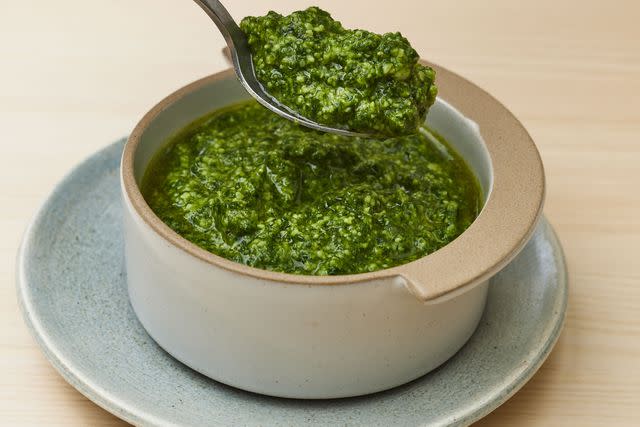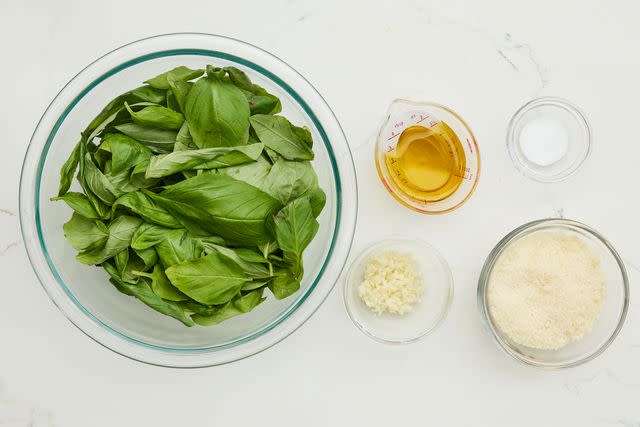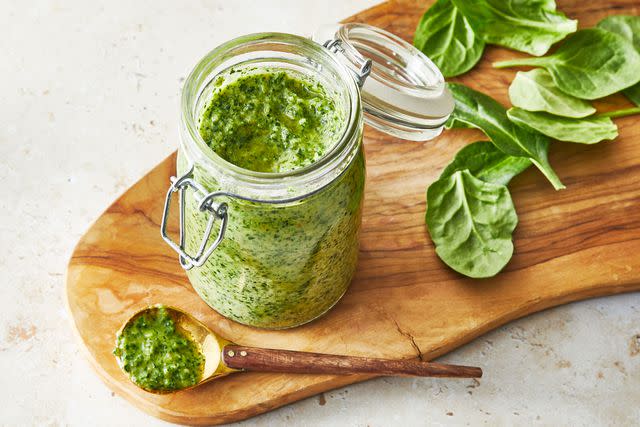What Is Pesto? Everything You Need To Know
The art of making and using pesto.
Chances are, even if you’ve never made pesto, you’ve enjoyed it on numerous occasions. The bright green sauce originated in Genoa, Italy. Today, it is used in countless ways in all types of recipes.
The original pesto made from garlic, pine nuts, olive oil, Parmesan cheese, and fresh basil leaves was made using a mortar and pestle. All of the ingredients were combined and blended with olive oil to form a paste. While pesto today can still be made via this method, it can also be made using a food processor or blender.
But that’s not all: Pesto can also be made with walnuts, pistachios, or hazelnuts instead of pine nuts—or no nuts at all, though this is technically pistou, a French condiment or sauce. You can skip the cheese if you’re serving vegan dinner guests, and you can also use a different leafy green such as arugula or even spinach.
Technically, pesto, from the Italian verb pestare, meaning to crush or to grind, refers to anything made by pounding or mashing ingredients together while pesto alla genovese refers to the original pesto developed in northwest Italy.
Pesto can be used as a sauce for pasta, dolloped on chicken or beef, or to brighten up a plate of roasted vegetables. It’s an incredibly versatile ingredient that lends itself to all kinds of dishes.
Related: 7 Recipes That Start With A Jar Of Pesto Sauce

Fred Hardy II; Food Stylist: Jennifer Wendorf; Prop Stylist: Julia Bayliss
Brief History and Origin of Pesto
Pesto originated in Genoa, Italy in the 16th century. It was traditionally made using a mortar and pestle. The fresh basil leaves—superior in the northwest region of Italy—are ground with pine nuts, crushed garlic, cheese, and salt. Olive oil is added to turn the ground materials into a paste that’s easy to work with, though the texture and consistency of the paste varies and can be a matter of preference.
Ingredients of Traditional Pesto
Traditional pesto contains just five main ingredients, six if you count the salt to taste. These ingredients are:
fresh basil leaves
olive oil
pine nuts
garlic
Another type of hard cheese, such as Pecorino or Grana Padano can be used in place of the Parmesan, and walnuts are often used as a replacement for pine nuts. Good extra-virgin olive oil is a key ingredient, as is fresh garlic, though in a pinch, you could substitute pre-minced jarred garlic.

Fred Hardy II; Food Stylist: Jennifer Wendorf; Prop Stylist: Julia Bayliss
Related: What's The Difference Between Olive Oil And Extra Virgin Olive Oil
How To Prepare Pesto
The traditional method for preparing pesto involves the use of a mortar and pestle. To make pesto the traditional way, which will results in a heartier textured sauce or paste, here’s a step-by-step guide:
Pound 1/3 cup of nuts (toasting them beforehand will make the pesto even more flavorful) until quite fine.
Add 1 to 2 cloves of chopped or crushed garlic to the bowl and pound using the pestle until a paste forms.
Next, add the basil leaves and a generous pinch of salt. You’ll need about two cups of loosely packed leaves.
Stir in 1/2 cup of cheese (Parmesan or Pecorino Romano) once you have a paste, and continue to pound using the pestle until the cheese is fully incorporated.
Stir in 1/2 cup of extra-virgin olive oil, and season to taste.
If you don’t have a mortar and pestle or you’re just a little short on time (even though the traditional method isn’t terribly time-consuming, it does require some elbow grease and takes more time than non-manual methods), you can use a food processor or blender.
First, combine the basil leaves, cheese, pine nuts, and garlic in a food processor or blender. Once these ingredients have come together, slowly add the olive oil while the machine is running. Season with salt, adding more olive oil if the mixture seems too thick.
Related: Types Of Basil You Should Try In Your Cooking

Caitlin Bensel; Food Stylist: Torie Cox
Culinary Uses of Pesto
Pesto is used in a variety of ways in a variety of dishes from pasta to poultry to omelets to vegetable dishes. It’s also great as a dip for bread, a nice alternative to butter or olive oil. Spread some on sandwich bread to add bright flavor or mix a couple of tablespoons with mayonnaise for an extra special condiment.
The Versatility and Flavor of Pesto
Because pesto lends itself well to substitutions, it is a wonderfully versatile sauce. Don’t have basil on hand? Put those carrot top stems to good use. Got leftover arugula? This peppery green is a great replacement for basil. Flat-leaf parsley can also be used in place of basil.
And, as we mentioned before, pine nuts, often rather expensive, aren’t mandatory either. Use a more affordable nut alternative like walnuts or skip the nuts altogether and make the French version, pistou.
Parmesan cheese may be the classic standby but it’s certainly not the only option. Really any hard cheese you have in your fridge can be substituted for the Italian hard cheese, though note that, depending on the flavor of the cheese, it may alter the taste of the dish.
For more Southern Living news, make sure to sign up for our newsletter!
Read the original article on Southern Living.

